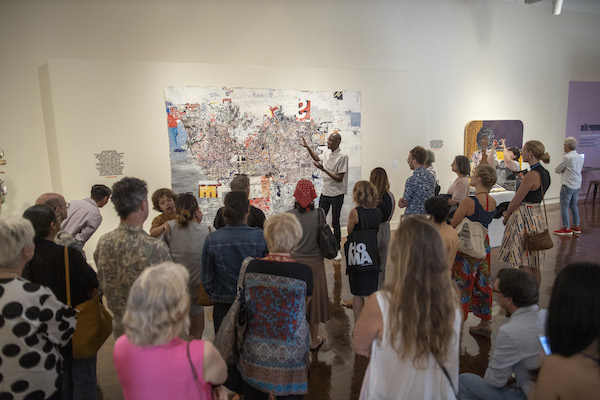Several weeks of cold rain and angry trade winds broke. At last, the balmy warm weather had been restored to the Hawaiian island of Oahu. The glorious outdoors beckoned, but many chose to fill the Doris Duke Theater of the Honolulu Museum of Art. Art star Mark Bradford was in town.
The affection was well deserved. The day before, Bradford had spent much time with each art grad student at the University of Hawaii at Manoa, including many undergrads. The grateful filled the first several rows.
The museum was featuring 30 Americans and their contemporary artwork, a show conceived by the Rubell Museum from their collection. Bradford headlined along with Basquiat, Lorna Simpson, Kara Walker, Carrie Mae Weems and Kehinde Wiley.
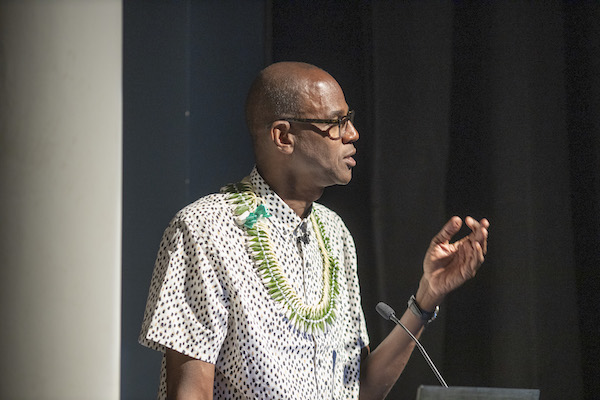
His biographical talk was polished. Bradford told tales of birth, life and biennials. We followed his career and its highlights, the agonies and the ecstasies, to this very moment in time with the artist. He was intimate with all. The art history of this CalArts kid was not uncommon to most. Bradford has very devoted fans.
As Bradford joked, his height is a popular question in every country and language. Beyond this obvious first impression, he is a man of warmth and intelligence that cannot be denied. It filled the room. It created laughter at every amusement, dread at every setback and relief at each success. Within moments, he had our full support. Many were predisposed.
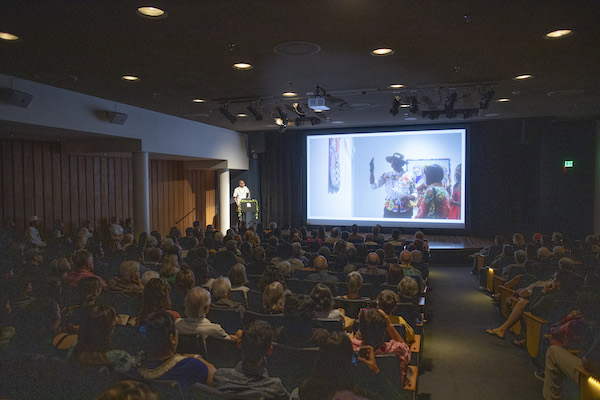
In our age when activism is a profession and activist an identity, Bradford brought the fury down to a calm and a personal responsibility. We help when we can. His aptly named Art + Practice, an arts community center in Los Angeles, is well known, documented and modeled. A critical need in the neighborhood was his simple motivation.
With a career that has developed organically, Bradford emphasized the ebb and flow of life, the synergy, which creates connections and therefore the choice of all action. His efforts for the 2017 Venice Biennale discovered a local prison program, which he championed. His involvement allowed the new organization to grow and flourish. He furthered lives to change and they gratefully accepted.
Bradford’s artwork has developed without gimmick or guile. His progression is organic, inspired by his natural environment. There is great history, dignity and honesty in his materials, process and palette.
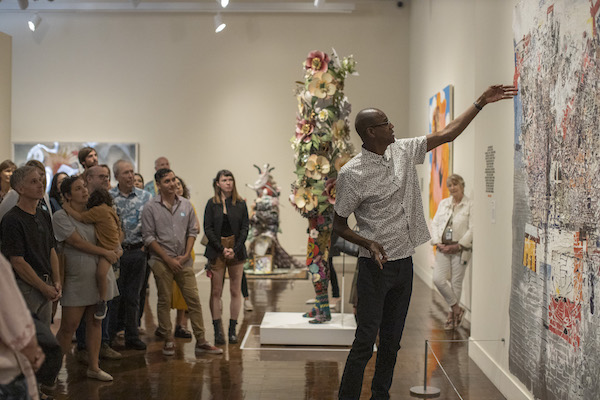
He credits his life to “having little self-esteem and no Plan B.” Truly, that is an organic evolution.
Bradford confessed that he helps because he once needed help. We all do. He spoke of the sapling that needs stakes to grow tall and upright or the construction scaffolding that supports a structure to rise. We all can.
At every stage of his life, Bradford has always stood above a crowd, always a target, an anomaly to the sightline. During the Q & A, a student who confessed that he had been raised among women in his mother’s dance studio, asked Bradford what had been the affect of growing up in his mother’s hair salon. He replied that it was the women’s quiet tenacity to survive and be happy. He advised, to great applause, “Find and surround yourself with those that celebrate you, not the ones that tolerate you.”
Raised by a single parent, Bradford’s self-reliance is the embodiment of his entrepreneurial mother. Survival depends upon market conditions; one sinks or swims upon the ability to react.
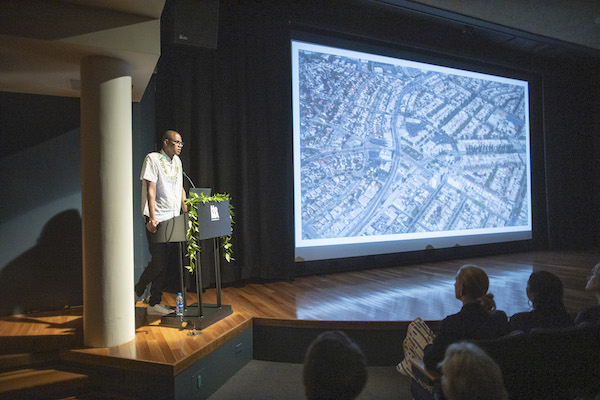
Bradford said that he was born in chaos and therefore he seeks structure. His work is one of apparent serendipity and randomness; every chance reduction to his surface will expose a new layer, color or image. The most shocking revelation of the presentation was the admission of his methodical control. Bradford knows every color of every layer and buried image; his notes document it all. He knows how far to dig in order to locate his treasure. There is nothing random or lucky in the creation of his work. If he might err, he can correct and add a new layer. So says the man who once had low self-esteem and no Plan B. So says the self-reliant man, ready to react to changing conditions. So says the man who is truly living his natural life.
The audience in the Doris Duke Theater was slow to disperse. Mark Bradford had created an intimate, comfy cocoon that I was reluctant to leave. Who knows? Outside, the weather may have changed back to calamity. But no, the late afternoon had stayed bright and sunny. The trades bounced and caressed. All is right with the world.
________________________________________________
Photo Credit: Honolulu Museum of Art; courtesy Hauser & Wirth.
GORDY GRUNDY is a long time arts writer and the publisher of ArtReportToday.com

